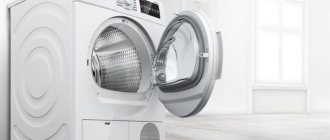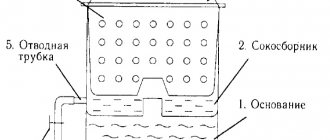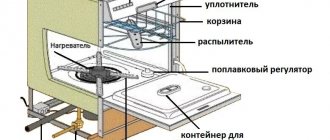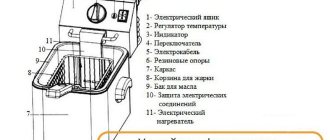General information
Vacuum (from the Latin vacuum - emptiness) is the state of gas or steam at a pressure below atmospheric.
Conventionally, different levels of vacuum are distinguished:
- Low - pressure range greater than 100 Pa
- Medium – pressure range greater than 0.1 Pa and less than 100
- Large – pressure range from 10-5 Pa to 0.1 Pa
- Ultra-high – pressure more than 10-5 Pa
With the modern development of equipment, creating a vacuum is not difficult at all. The simplest unit capable of creating a vacuum is a vacuum pump.
The operation of all types of pumps is based on one principle, namely displacement. It underlies the operation of all pumps of different volumes and methods of use. Displacement involves getting rid of gas from the working compartment. During the action, the pressure changes, and the gas elements move along the correct path. With the modern development of equipment, creating a vacuum is not difficult at all. The simplest unit capable of creating a vacuum is a vacuum pump.
There are types of pumps used in everyday life (for example, conveniently storing clothes or extending the shelf life of food). Knowing how the equipment operates will help you find a reliable device for creating space with rarefied air.
The efficiency of the pump is directly dependent on the quality of the displacement principle. The amount of vacuum that can be created in a closed atmosphere is affected by the tightness of the working compartment. This is achieved through spool valves, impeller and plate. The last two items can be found on the outside of the vacuum pump.
Device in a diesel engine
The diesel engine includes a rotor, the blade of which divides the space into 2 parts. When the rotor rotates, which is not located in the center, the working space on both sides either decreases or increases.
Often used to lower the temperature of certain engine components.
The oil passes through a special channel, covering and sealing the blades. And for the pump to serve well, you need a connection diagram and the right choice.
The main selection criteria are:
- Maximum outlet pressure;
- Good starting pressure;
- High degree of productivity.
The diesel engine has good efficiency.
Individual mechanisms are not suitable for releasing gases into the atmosphere after pumping, so a forevacuum is created for them. The maximum pressure needs to be measured in a tightly closed container. Maximum outlet – high pressure. The species mentioned are measured in Pascals. Also, during the purchase, you need to take care of the size, pumping stages and their number, engine power, number of revolutions.
Factors that indicate the correct operation of the vacuum pump
There are two necessary actions that absolutely any vacuum pump must perform. He must:
- Create a vacuum of a given depth while pumping out the gas element from the required space without interruption;
- Complete the first step in a clearly defined time.
If any point is not fulfilled, it will be necessary to connect an additional pump. For example, if the pressure of the required volume was not provided within a given period of time, a forevacuum type pump is connected. It allows you to reduce the pressure in the required amount to ensure a working atmosphere. This principle is similar to a serial connection. If the required pumping speed has not been obtained, it is necessary to connect a pump capable of creating the required vacuum at high speed. This type of operation is comparable to a parallel type connection.
The size of the depth created by the vacuum is affected by the tightness of the working atmosphere. It is provided by pump components, or rather by a special type of oil. Oil allows you not only to make the gaps tight, but also to close them tightly. A pump that is capable of creating a vacuum and has such a design is considered an oil pump. A dry pump is one that provides operation without oil. Dry pumps are more common in use because they do not require special maintenance.
The operating principle of a vacuum pump varies, as each type works differently. You can read more about the types about Types of vacuum pumps.
Let's look at the three most popular types of vacuum pumps used in production.
What is a foreline pump?
The fore-vacuum pump is an inseparable part of absolutely any system. It pumps out the required volume to medium and low levels, while maintaining outlet pressure. The volume of the forevacuum chamber and power affect the speed of operation.
The foreline pump has a long service life
The pump can be dry or oil. Oil cooling in pumps makes them the most popular in use.
The newest structure allows you not to worry about the rapid contamination of the device with oil vapors; a check valve during operation prevents the release of oil. And the inlet and exhaust filter make the process even cleaner. As they improved, fore-vacuum pumps began to be invented without contact between oil and gaseous medium. They are also called dry.
Forevacuum pumps are:
- Spiral;
- Synthetic;
- Diaphragmatic;
- Rotary;
- Claws.
The implementation of such pumps is complex, so they are much more expensive. The shortcomings that oil pumps had were eliminated. But their maintenance requires more careful and frequent disposal and oil changes. Also, some oils cost much more than the pump itself. This is quite unprofitable. All the variety of dry pumps is due to the fact that there is no one optimal option that fits everywhere. Each pump is designed for its own purpose. Every year their improvement increases. But their main drawback - extremely low pressure - still remains. However, the problem can be solved by installing a second booster vacuum pump.
Rotary vane vacuum pumps
They are also called oil ones. Let us analyze information about the design and principle of operation of a rotary vane type vacuum pump.
These vacuum pumps look like a carefully polished cylinder with a rotor inside. The side gap varies in size because the axis of its inner part and the rotor do not touch.
The rotor has special motor plates. Thanks to their springs, they adhere to the body. In this way, the empty atmosphere is divided into parts of variable volume. During motor activity, the gas element creates a vacuum in the intake pipe. In pressure, there is excess pressure.
The plates contain antifriction components or special low-viscosity oils, since it is necessary to reduce plate friction. This makes it possible for a vacuum of great strength to appear. However, the pumped elements must be clean.
Main differences from the compressor
The differences between a vacuum pump and a compressor are as follows:
- Atmospheric and received pressure are not capable of having a difference greater than 760 mmHg.
- The reduction in air mass as it enters as the vacuum level increases while the compressor has constant efficiency and pressure.
- The pump passes a much smaller amount of air with increasing pressure, and the heat dissolves inside the mechanism, so vacuum equipment does not have difficulties in removing heat.
A vacuum pump transforms mechanical energy into pneumonic energy by pumping out air. The pressure percentage decreases. The amount of gas pumped out affects the rate of work done. The steps taken are similar to air compressors, but the ejection of air from a closed volume is eliminated. The main difference between these two devices is the output of an “absorbing” line of pressure less than atmospheric, which almost disappears with a vacuum of a higher stage.
If the unit is discharged, there is no need to rush to seek the help of specialists. It is possible to repair a house or create a new pump, for example, from a car pump. And the correct connection of the unit will definitely ensure a high level of operation.
Diaphragm vacuum pumps
The flexible diaphragm is the main part of the operating principle of a diaphragm piston pump. The membrane is connected to the lever mechanism. It is created from the latest composite components that can withstand mechanics. The outer parts of the membrane are firmly attached to the body part, and the central part is bent under the influence of an electric and pneumatic drive. In this way, the inside of the chamber is alternately reduced and enlarged.
The volume changes together with the processes of obtaining and releasing new gaseous or liquid elements. When antiphase combines the actions of two membrane components, a continuous pumping mode occurs. Another element of the pump, namely valves, determines the correct direction of flow and distribution motives. The mechanism does not have elements that can rotate or experience friction and come into contact with the product being pumped.
Advantages of diaphragm piston pumps:
- Tightness
- Dry use for long periods of time
- Using a pneumatic drive in an explosive environment
- Economical.
Advantages of a membrane type unit
This type of pump is used when pumping solutions and liquids that have different viscosities and aggressiveness. They are distinguished by the absence of an engine. The paint and varnish, food, and oil refining industries will not be able to do without such a pump for a day.
The main components are 2 membranes, combined with a rod in the middle of a pair of disks.
When working with powerful pumps, safety rules must be observed.
Air enters first into one chamber, then into another, carrying out a centrifugal cycle of actions, which then return. The valve spool redistributes the medium. The liquid is distributed in the following order: intake manifold - working chamber - exhaust manifold.
What are the advantages of diaphragm (membrane) pumps:
- There is no need to repair parts, since wear does not occur;
- Reliable, simple design;
- Eliminates the formation of sparks, reliability when working with flammable materials;
- If adjustments are necessary, only the air supply volume should be changed.
Impurities do not get inside due to the high level of tightness of the device. They are used in areas where leakage is prevented and sterility is maintained. These are the chemical and food industries, laboratory research, medicine, and printing. The device is completely safe for both animals and people, which is why milking machines are equipped with them. The advantages are considered silent, low energy consumption and compactness.
Screw Vacuum Pumps
Screw-type pumps, like all others, operate using the displacement principle. However, unlike other devices, it occurs along a screw, which performs the work of rotation. The pumps have: a drive, 1-2 screw-shaped rotors and a stator of the desired shape. The pumped component does not return back because the parts are manufactured with great precision - this guarantees high-quality pump performance. As a result, excess pressure appears and a vacuum appears in the receiving part.
Pros of screw pumps:
- Minimum noise
- Pumping of components thanks to mechanics
- Even spending
It is important to choose the type of pump according to the requirements of your enterprise and industry. To do this, it is better to seek advice from specialists.
Features of water ring equipment
This type of pump is designed to create an aqueous environment with the required level of gas pressure. Centrifugal forces form the work of the pump, pumping out gas due to the formation of a ring. And through the ring, low pressure appears inside.
A liquid ring pump is an apparatus consisting of a cylinder-shaped drum with a span for inlet and outlet.
There is a sealing ring from which purified steam comes out during operation. When the rotor starts, the water is pressed against the cylindrical “shell”, a cavity (loose vacuum) is formed, shaped like a sickle. This type of pump is very popular.
From time to time, water ring equipment should be serviced by replacing worn parts.
They have a number of advantages:
- Unpretentious design;
- Strength;
- Cheap repairs;
- Reliability;
- Economical.
Repairs are done quite rarely, because the elements do not come into contact with each other, and parts do not wear out. Valves, which most often need repair, are missing, as are gears. Rotor bearings need lubrication as they interact with water. There is a risk of breakage only if the sealing ring is neglected. But in general, a liquid ring pump is economical and reliable.
Types of high-vacuum devices
This type of units is designed for pressure relief. The principle of operation may differ when working with a foreline pump, which provides the proper level of vacuum.
There are several types of pumps:
- Cryogenic;
- Magnetic discharge;
- Turbomolecular;
- Diffusion.
Diffusion ones are used in excavations, creating instruments, alloying various metals, and storing medicines. The cryopump is the simplest of all the others. It does not have a liquid medium, so the possibility of contamination is excluded. And also it has a minimum cost, producing the highest quality work. The main condition for the operation of a magnetic discharge device is that titanium is sprayed with gas in equal quantities.
The vacuum pump is often painted blue
The main mechanism for pumping out inert gases is the entry of ions into the cathode material.
To maintain a high vacuum, a turbomolecular pump is used. The speed of its action is determined by the pumping speed. Power and friction increase due to increased pressure. Reliability increases by preventing surface shells from appearing. The drive is controlled by a controller.











